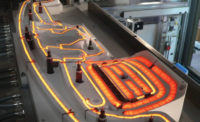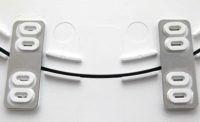Heat staking is a well-known method of heating and forming a molded plastic stud or boss to secure another component. The process has numerous benefits. It’s quick and inexpensive. It can join dissimilar materials, and it eliminates the cost of fasteners and adhesives.
Until recently, the only way to heat the boss was with hot air, ultrasonics or a heated tool. Then, in 1999, we introduced an alternative process—InfraStake. This unique process represents a paradigm shift in the staking process, and it has now been proven in countless applications.
As the InfraStake name suggests, the energy source for the process is infrared light, and the heat transfer mode is radiation. The InfraStake module clamps the components together, heats the boss evenly with precisely directed infrared light, and forms the plastic with an unheated punch driven by a low-force pneumatic cylinder.
Conventional Staking
Several methods for heat-staking plastic parts exist. These methods can be used with reasonable success for most thermoplastic resins. Some of the more common materials that are staked include polyethylene, polypropylene, ABS, polycarbonate, acetal and polyamide. Heat staking is effective with resins that contain fillers such as glass or talc, given reasonable process control measures are in place.
The more traditional methods include: hot-air staking, thermal staking (staking with a heated punch), and ultrasonic staking. All these processes melt and form plastic. However, they each have certain weaknesses when it comes to minimizing cycle times and producing consistent, high-quality assemblies with acceptable joint strength. Some of those weaknesses include inadequate part clamping; inducing stress in the formed stud; marking Class A surfaces; component damage due to high-frequency vibrations; high operating costs; danger to machine operators; plastic stringing or sticking to the punches; and process variation.
The struggle to overcome these weaknesses ultimately led to the development of the InfraStake process.
Clamping and Heating
The InfraStake process consists of four steps: clamping, heating, forming and retracting.
News flash: Industry experts have recently discovered that plastic parts are not always known for their dimensional stability! One of the first challenges when staking components together is making certain that they are properly preassembled. Because actual molded parts don’t always match the CAD models, an assembly process that can compensate for some part variation (warp) can be a real advantage. The InfraStake process clamps the parts together at each stake point, ensuring that they are firmly pressed together throughout the entire cycle. In most cases, this eliminates the need for secondary clamps.
The InfraStake process works with thermoplastic materials of all different types, colors and transparencies. Dark, opaque materials absorb infrared energy more quickly than light, translucent materials, so cycle times are shorter for them.
The energy source used in the process is a technical-grade halogen lamp that emits a high output of infrared light. As the lamp is energized, a reflector directs the infrared energy from the filament into a column. This column of energy travels downward until it is focused by the concentrator to the full perimeter of the boss.
The InfraStake module transfers the infrared energy from the lamp to the boss through radiation. Because the working area around the boss is completely encapsulated, the operator cannot access the point where the infrared energy is being focused. Even when the operator can contact the outside of the InfraStake module during the staking process, the surface temperature remains safe to the touch.
This is possible because the reflective surfaces are plated with gold, which is very efficient at reflecting infrared energy. This improves both the safety and the efficiency of the process by keeping the energy where it is needed and nowhere else. Without the risk of burning the
operator, a simple press mechanism can often be used on machines that would otherwise require heavy guarding, a shuttle, or a turntable for operator protection.
The ability to focus the infrared energy precisely where it is needed also minimizes power consumption. Unlike a hot-air or heated punch process, which typically use a 400-watt heater for each stake point, InfraStake modules use lower-wattage lamps. The ISM20 module is equipped with a 35-watt lamp; the IS125 module is equipped with a 100-watt lamp. Since the price of electricity hasn’t been going down recently, this has a real impact on the operating cost of the equipment.
Additionally, because the system does not have any internal components that have to warm up before use, no preheating is necessary. Finally, the system uses only a small amount of cooling air, which minimizes the amount of compressed air required.
The InfraStake process heats the boss uniformly until the plastic reaches a semimolten state. The infrared energy is focused only on the portion of the boss that extends through the mating part, so there is very little chance of affecting the show surface opposite the boss. The standard round profile works well for many different boss shapes, but the reflective surface geometry also can be tailored to noncircular bosses, such as blade or tab studs.
The process parameters for the heating portion of the InfraStake cycle are quite simple. The lamp is either on or off, and the amount of infrared energy transferred to the boss is determined by the power level or the amount of time that the lamp is on.
The other parameter that affects the heat cycle is the flow rate of the cooling air. A small amount of cooling air flows through the InfraStake module during the staking cycle. This is done for several reasons. It stabilizes the temperature of the lamp and lamp holder, and it maintains positive pressure in the area surrounding the polished reflective surfaces.
Positive pressure keeps the surfaces clean by keeping out dust, airborne contaminants and potential plastic outgassing. The cooling air also helps regulate the surface temperature of the boss to prevent overheating. Finally, the airflow keeps the punch relatively cool so it can effectively remove the heat from the plastic once it makes contact with the material.
The InfraStake controller error-proofs the process by monitoring the current draw of each module during the heat cycle and alerting the operator if there is a problem. The InfraStake body has integral, machined tracks that accept proximity sensors triggered by the position of the punch coupler magnet. These sensors can be used to verify that a boss is present before the cycle and to verify that the punch has extended completely at the end of each staking cycle.
Forming and Retracting
The InfraStake process uniformly heats the boss to a semimolten state. As a result, a low-force, pneumatic cylinder is sufficient to drive the punch and form the stud, minimizing stress and the potential for part damage. This is especially advantageous for delicate applications such as circuit board assemblies. The punch cavity is designed and machined to match the volume of plastic in the unstaked boss. This ensures that each stake is fully formed.
The punch is positioned outside of the infrared focal point. This, coupled with the cooling airflow within the module, assures a reasonable operating temperature at which molten plastic can be cooled quickly after the forming process. This prevents plastic from sticking to the tool.
When staking glass-filled materials, which can be abrasive, the punch detail is often machined from hardened tool steel to prevent wear.
Several geometries can be used for the punch cavity. For round bosses, the dome style and the rosette style are quite common, and the strength of each style is comparable. In fact, the diameter of the clearance hole in the mating part often affects joint strength more than the punch geometry. The dome punch design minimizes the distance that the plastic must be displaced, and the lack of a center pilot reduces its sensitivity to bosses that are slightly off-center. As a result, it often can provide a larger process window than a rosette design. Rectangular shapes also can be used if necessary when staking features such as tabs.
The final step in the InfraStake cycle is to retract the punch. At this point, it is important that the plastic has resolidified to the point where it can maintain its reformed shape and clamp force on the opposing surface. If it does not, the stake joint may loosen or the plastic may stick to the punch. The InfraStake concentrator functions as a stripper plate, holding the part down and preventing it from lifting as the punch retracts. The InfraStake module is only removed from the part after the punch has retracted from the staked boss.
Boss Sizes and Geometries
The InfraStake process can be used to stake bosses of varying shapes and sizes. Multiple standard modules are offered and custom designed and machined modules are commonly produced. Extol provides consultation to optimize stud design to assure a feasible and robust assembly process.
Although relatively new in the industry, InfraStake technology has a proven performance record. More than 10,000 modules are in production, serving numerous industries in locations around the globe. For more information, e-mail bill.reed@extolinc.com or visit www.extolinc.com.
ASSEMBLY ONLINE
For more information on plastics assembly, visit www.assemblymag.com to read these articles:











